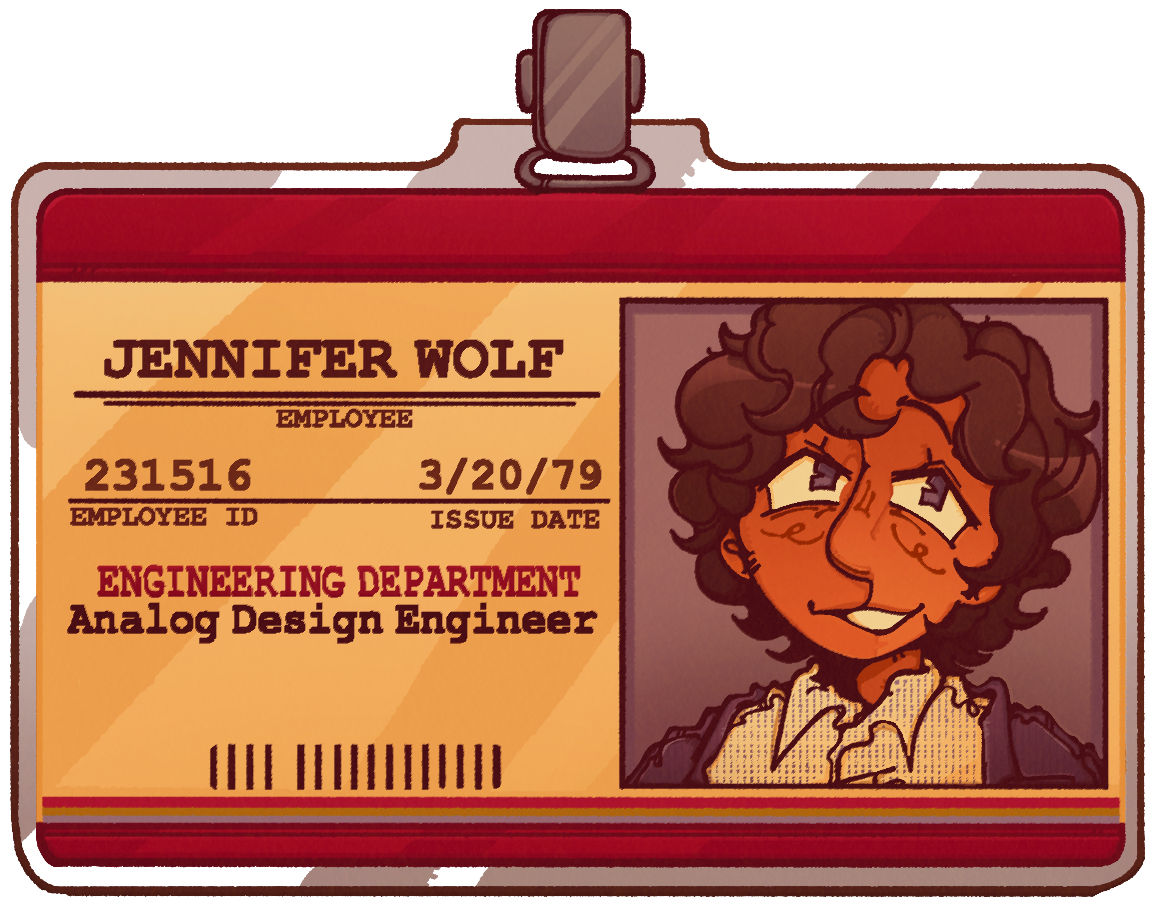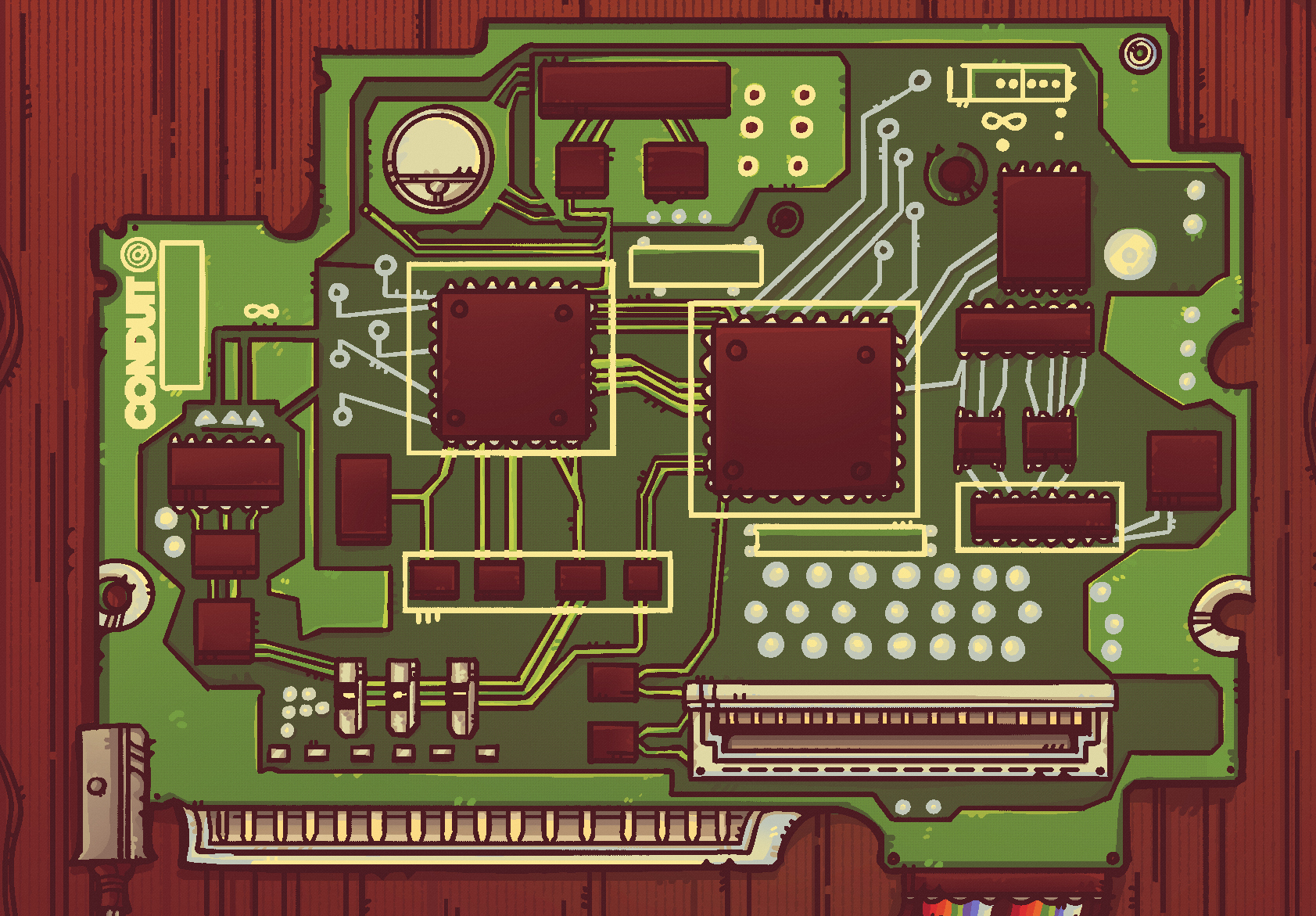An Interview With Analog Enginner,
Jennifer Wolf.

Wolf's work ID from Conduit.
Q. Before we start digging into your time at Conduit, What were you doing beforehand?
A. I would've still been living in Maryland, getting my Bachelor's at JHU I believe. I remember it was an interesting time to be getting into the tech field since computers were beginning to shrink down and make their way into people's homes, slowly becoming something more familiar to us. Originally, I was looking into studying programming but I became drawn to engineering due to it being more physical. It was more satisfying to me in that regard.
Q. How did you first learn about Conduit?
A. I had just completed my degree and moved to New York, looking for work. I think that's the common answer everyone who worked at the company gives if you were to ask them, especially back in '79. I had seen several spots in the paper they had put out, along with the occasional article about them. I thought IBM, my original choice, was a bit of a boys club, so I decided to apply for an engineering position at Conduit instead.
Q. Were most employees at Conduit fresh out of college?
A. Definitely a large majority, but there were some older people employed as well. Most of them were people the founders knew beforehand or were people who had the experience required to run certain departments.
Q. What did your job at Conduit entail?
A. Well, when I got hired, the hardware department consisted of only a handful of people. That meant I was usually tasked to do multiple things. Mainly I was brought onto projects to be a hardware wizard or an analog designer, which in short, means I was responsible for optimizing and designing the circuits of the products the company produced.
Q. Did you find it difficult having to switch between the two?
A. Oh not at all! With how much overlap there is between the two positions, I'd hardly break a sweat when drafted onto a project as one or another.
Q. How long did you work with the company?
A. Just short of 7 years. I was given a better opportunity at a different company and left just a year after the Conduit I launched. I remember my last day in the office very vividly, was very hard not to get teary-eyed anytime someone stopped by my cubicle to wish me luck. The people apart of the Conduit I team were especially close, so I kept in contact with a good majority of them after I left. I still do!
Q. What projects did you work on at Conduit?
A. I mostly worked on developing computer upgrades at the start. Things such as sound and graphic cards. Then around 1982, I was picked to work on the Conduit I project to help develop and design its hardware components. If I recall correctly, I had made the logic board for the machine, along with designing most of the analog circuit boards.

A photo of one of the boards Wolf designed.
A lot of the work on the Conduit I was collaborative. I received a bunch of advice while developing the logic board from this other engineer on the project, Charles Hoffman. He helped me figure out how to squeeze out as much performance as I could out of the chips I used. Sylvia Karmicheal, the head of the hardware department, would come in from time to time and lend a hand on certain things as well, mostly with optimization and running test on our boards. Omar Nasseri, the CEO, would also come in to oversee the progress made. He'd helped keep the entire team on course and make sure deadlines were met to avoid any possible delays.
Q. Do you remember what the company's goal with the Conduit I was, Hardware wise?
A. I believe the goal was to have a computer that could be 32-bit, without 32-bit speeds. Most of the focus was on making the PC run as fast as it could while pushing the limits on what could be pushed out of the boards. I remember the specific focus on making a 32-bit machine came from Guzmán, the software director of the company. There were already some 32-bit computers on the market, but he specifically wanted one that “truly felt like it was a 32-bit machine.” He was very focused on getting the most and the best performance out of every square inch of the PC.
Q. Did you ever work closely with Guzmán?
A. No. He would visit the hardware department sometimes, mostly during CI development to view progress and point us in the right direction with certain things, but I never got the opportunity to work with him up close as I did with Sylvia and Nasseri.
Q. How long was the Conduit I in development for?
A. Development ran from 1982 to 1983, so around a year. I think hearing that now in modern times is a bit shocking, but it was very commonplace for computer products at the time. If development took 2 years? 3? Your product would have already been seen as outdated by that time. I never found the short time frame stressful. It was the normal everyone in the industry was used to.
Q. What was it like working with Sylvia Karmicheal?
A. I remember her being very pleasant to work with. She was something of a "hot topic" in both some papers and the office at the time due to her familial ties. She had come from a pretty wealthy family back in Manchester I believe, so it was somewhat of a surprise to see her funding the company out of her pockets during its early years, along with being pretty hands-on with all of the inner workings. She was a very smart woman and I found myself learning a lot from her during my time at Conduit.
Q. And Nasseri?
A. Omar was always a pleasure to work with. He had the skill to contribute strong ideas to every department he worked with. He was also very knowledgeable on hardware engineering from his time at IBM, so he would come into our department and suggest ideas for ways to get better performances out of fewer parts. He and Sylvia created a great team when it came to hardware development. It became something of a joke within our department that you could put those two in a room for days on end and they wouldn't run out of ideas to bounce off one another.
Q. To close things off, do you have any fun tidbits from your time at Conduit you'd mind sharing?
A. I do! I thought you and your archival group you work with would find these interesting, so I pulled them out of storage to show off.

Conduit brand sweater and computer bag.
It was a piece of memorabilia the Conduit I team was given some time after the launch as a thank-you gift. I don't recall if I ever used the bag, but I know I've worn the sweater on some occasions when it was particularly chilly in New York.